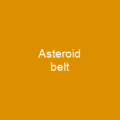Asteroids: The Unseen Guardians of Our Solar System
Imagine a vast, unexplored territory floating between the planets Mars and Jupiter—this is where asteroids reside. These minor planet objects, larger than meteoroids but smaller than full-fledged planets, have intrigued scientists for centuries. But what exactly are they? And why do we care so much about these space rocks?
The Birth of Asteroids
When you think of asteroids, you might picture a collection of random space debris. However, the truth is far more fascinating. Most asteroids are believed to be remnants from the early days of our solar system, when planetesimals failed to coalesce into full-fledged planets due to gravitational disturbances. Some larger asteroids like Ceres and Vesta even managed to melt and differentiate, forming cores and mantles similar to terrestrial planets.
Classifying Asteroids
Asteroids are not just a bunch of rocks floating around; they come in different types based on their composition. The three main categories are C-type (carbonaceous), M-type (metallic), and S-type (silicaceous). Each type offers unique insights into the history and evolution of our solar system.
The Main Asteroid Belt
Most asteroids reside in the main asteroid belt, a region between Mars and Jupiter. This belt is estimated to contain millions of asteroids, with some being as large as 1000 kilometers in diameter. The largest known asteroid, Ceres, even has enough mass to be classified as a dwarf planet.
Near-Earth Asteroids (NEAs)
While the main belt is home to most asteroids, there are also Near-Earth Asteroids that come closer to our planet. These NEAs pose both potential threats and opportunities for exploration. NASA and other space agencies have launched several missions to study these objects, including OSIRIS-REx, which returned samples from asteroid Bennu in 2023.
Active Asteroids
Some asteroids exhibit comet-like behavior, with jets of gas and dust emanating from their surfaces. These active asteroids challenge our traditional understanding of the difference between asteroids and comets, suggesting a more fluid classification system.
The Hunt for Asteroids
Asteroid hunting has come a long way since the discovery of Ceres in 1801. Early methods involved visual observations with telescopes, but modern techniques like astrophotography have revolutionized our ability to detect and study these objects. Today, dedicated space missions are providing us with unprecedented insights into their composition and behavior.
Observation Techniques
Ground-based observatories can provide valuable data on asteroid shapes and compositions through light curves and spectral analysis. However, for detailed imaging and precise measurements, spacecraft flybys remain the gold standard. Missions like Dawn, which orbited Vesta and Ceres, have given us a wealth of information about these distant objects.
The Future of Asteroid Exploration
As our understanding of asteroids grows, so does the interest in their potential uses. Asteroid mining is no longer just a concept; it’s becoming a reality with plans for sample-return missions and even commercial ventures. The resources found on asteroids could revolutionize space exploration and even provide solutions to Earth’s resource depletion issues.
Defending Against Asteroids
While the potential benefits are exciting, we must also consider the risks posed by near-Earth asteroids. NASA is working on strategies to deflect or destroy potentially hazardous objects before they can impact our planet. The Double Asteroid Redirection Test (DART) mission, which successfully impacted a moon of Didymos in 2022, demonstrated that such technologies are feasible.
Conclusion
Asteroids may seem like mere rocks to the untrained eye, but they hold the keys to understanding our solar system’s history and potential future. From their classification into C-type, M-type, and S-type asteroids to the active research being conducted on Near-Earth Asteroids, these space objects continue to captivate scientists and inspire new generations of explorers.

You want to know more about Asteroid?
This page is based on the article Asteroid published in Wikipedia (retrieved on March 9, 2025) and was automatically summarized using artificial intelligence.






